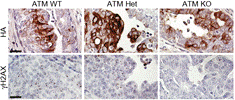Veterinary and Biomedical Sciences, Department of
Document Type
Article
Date of this Version
2004
Citation
Proceedings of the National Academy of Sciences (August 10, 2004) 101(32): 11,743-11,748. DOI: 10.1073/pnas.0403832101.
Abstract
Copolymer 1 [Cop1, glatiramer acetate, Copaxone, poly(Y,E,A,K)n] is widely used in the treatment of relapsing/remitting multiple sclerosis in which it reduces the frequency of relapses by ≈30%. In the present study, copolymers with modified amino acid compositions (based on the binding motif of myelin basic protein 85–99 to HLA-DR2) have been developed with the aim of suppressing multiple sclerosis more effectively. The enhanced efficacy of these copolymers in experimental autoimmune encephalomyelitis (EAE) induced in SJL/J mice with proteolipid protein 139–151 was demonstrated by using three protocols: (i) simultaneous administration of autoantigen and copolymer (termed prevention), (ii) pretreatment with copolymers (vaccination), or (iii) administration of copolymers after disease onset (treatment). Strikingly, in the treatment protocol administration of soluble VWAK and FYAK after onset of disease led to stasis of its progression and suppression of histopathological evidence of EAE. The mechanisms by which these effects are achieved have been examined in several types of assays: binding of copolymers to I-As in competition with proteolipid protein 139–151 (blocking), cytokine production by T cells (T helper 2 polarization), and transfer of protection by CD3+ splenocytes or, notably, by copolymer-specific T cell lines (induction of regulatory T cells). The generation of these copolymerspecific regulatory T cells that secrete IL-4 and IL-10 and are independent of the immunizing autoantigen is very prominent among the multiple mechanisms that account for the observed suppressive effect of copolymers in EAE.
Included in
Immune System Diseases Commons, Medical Biochemistry Commons, Medical Immunology Commons, Medical Molecular Biology Commons



Comments
Copyright 2004, PNAS. Used by permission.